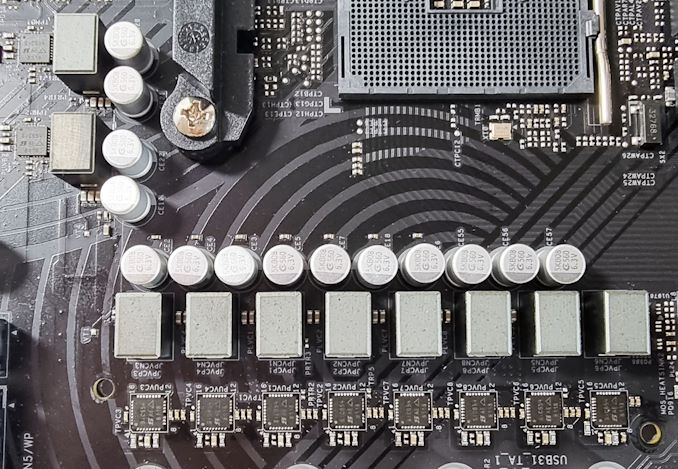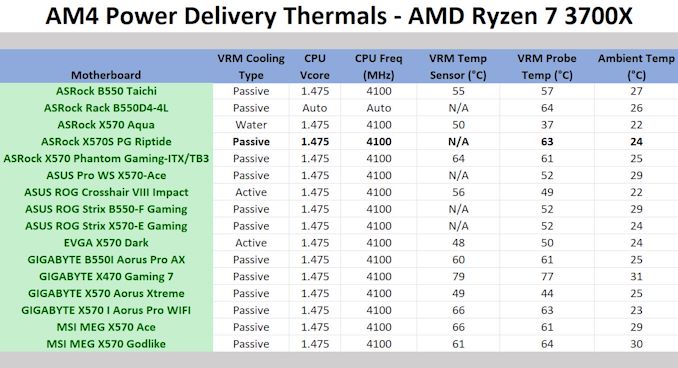The ASRock X570S PG Riptide Motherboard Review: A Wave of PCIe 4.0 Support on A Budget
by Gavin Bonshor on October 22, 2021 9:00 AM ESTPower Delivery Thermal Analysis
One of the most requested elements of our motherboard reviews revolves around the power delivery and its componentry. Aside from the quality of the components and its capability for overclocking to push out higher clock speeds which in turn improves performance, is the thermal capability of the cooling solutions implemented by manufacturers. While almost always fine for users running processors at default settings, the cooling capability of the VRMs isn't something that users should worry too much about, but for those looking to squeeze out extra performance from the CPU via overclocking, this puts extra pressure on the power delivery and in turn, generates extra heat. This is why more premium models often include heatsinks on its models with better cooling designs, heftier chunks of metal, and in some cases, even with water blocks.

The 10-phase (8+2) power delivery operating at 4+2 on the ASRock X570S PG Riptide
Testing Methodology
Out method of testing out if the power delivery and its heatsink are effective at dissipating heat, is by running an intensely heavy CPU workload for a prolonged method of time. We apply an overclock which is deemed safe and at the maximum that the silicon on our AMD Ryzen 7 3700X processor allows. We then run the Prime95 with AVX2 enabled under a torture test for an hour at the maximum stable overclock we can which puts insane pressure on the processor. We collect our data via three different methods which include the following:
- Taking a thermal image from a birds-eye view after an hour with a Flir Pro thermal imaging camera
- Securing two probes on to the rear of the PCB, right underneath CPU VCore section of the power delivery for better parity in case the first probe reports a faulty reading
- Taking a reading of the VRM temperature from the sensor reading within the HWInfo monitoring application
The reason for using three different methods is that some sensors can read inaccurate temperatures, which can give very erratic results for users looking to gauge whether an overclock is too much pressure for the power delivery handle. With using a probe on the rear, it can also show the efficiency of the power stages and heatsinks as a wide margin between the probe and sensor temperature can show that the heatsink is dissipating heat and that the design is working, or that the internal sensor is massively wrong. To ensure our probe was accurate before testing, I binned 10 and selected the most accurate (within 1c of the actual temperature) for better parity in our testing.
For thermal image, we use a Flir One camera as it gives a good indication of where the heat is generated around the socket area, as some designs use different configurations and an evenly spread power delivery with good components will usually generate less heat. Manufacturers who use inefficient heatsinks and cheap out on power delivery components should run hotter than those who have invested. Of course, a $700 flagship motherboard is likely to outperform a cheaper $100 model under the same testing conditions, but it is still worth testing to see which vendors are doing things correctly.
Thermal Analysis Results

We measured 57.7°C on the hottest part of the CPU socket during our testing
The ASRock X570S PG Riptide is using a 10-phase power delivery, which is split into an 8-phase design for the CPU VCore, and a 2-phase setup for the SoC. The CPU section is using eight Vishay SIC654 50 A power stages operating with two UPI UP1911R smart PWM doublers that are quadrupling the power stages in a 4+0 configuration. The SoC is using two independent Vishay SIC654 50 A power stages, with a UPI UP9595S PWM controller operating in 4+2 mode. Cooling the power delivery is a single heatsink that doubles up as the board's rear panel cover. It's not very weighty and relies on good passive airflow over a large plate over the top of the heatsink.
Looking at how the ASRock X570S PG Riptide performed in our thermal VRM testing, it did pretty well considering it's an entry-level to mid-ranged X570(S) model. We measured a temperature of 63°C from our K-type thermocouple and got a reading of 57.7°C from the hottest part of the CPU socket area when using our FLIR thermal imaging camera. Unfortunately, the PG Riptide doesn't use an integrated VRM thermal sensor.
Comparing the PG Riptide to other AM4 models we've previously tested, it does sit near the warmer boards we've tested, but it's still well within specifications and performs as expected given the price point the board sits at.











39 Comments
View All Comments
Threska - Sunday, October 24, 2021 - link
Nothing says "canary" as a precursor to the fall of society as the decline of social skills. Soon we all will be communicating in the language of "road-rage".Spunjji - Monday, October 25, 2021 - link
I certainly think education on critical thinking would be of use, but I'm not so sure about fallacies specifically - your example is instructive here, as when lawyers use fallacies, they tend to do so in full knowledge of what they're doing. The target audience are likely to assess the information according to their priors - knowing that they've been presented with a fallacy is unlikely to sway them if they happen to agree with the conclusion.We saw this recently in the UK with a court decision (now overturned) that barred prescribing puberty blockers to trans children on the basis of an assumption that correlation entails causality; whenever this was pointed out people tended to respond by insisting that it was still the right decision for some other (usually unproven or false) reason.
Education on critical thinking is sorely lacking. I didn't get a grounding in subjects like formal logic and epistemology until I studied Philosophy as an undergraduate (I'm in the UK and was educated in a state school, for context).
Oxford Guy - Friday, October 29, 2021 - link
Enough education on fallacies would, hopefully, get them removed from serious discourse. The audience of lawyers is not only the highly-educated. Also, even those with advanced degrees are often only given cursory training in fallacies. The cram-then-forget style of so much of higher education is part of the problem. There is also pressure on all people in a society dominated by fallacies to cave.‘Critical thinking’ should also be reframed as ‘true thinking’ or similar — to remove the false implication that ‘critical’ thinking is special (therefore optional/compartmentalized) rather than the only kind of thinking that yields accurate understanding.
Another massive problem is bad terminology, terminology that so often enables people to avoid the rigor of rationality. When people hear of ‘critical thinking’ they are inclined to believe it’s an academic exercise rather than the way thinking should be approach generally. The embedded word critic also implies combativeness, an excessively-judgmental mentality. Given the strong appeal of conformity (i.e. being ‘chill’), such connotations are counterproductive.
opinali - Saturday, October 23, 2021 - link
The problem with this idea is the economics. If we make the Cartesian product of all CPU models even within a class, all motherboard models, RAM and SSD capacities, plus other variants that exist already (high-end Ethernet or not etc.), that's a truckload of possible SKUs. Unless you pick a one size fits all choice.TheinsanegamerN - Saturday, October 23, 2021 - link
I've got a better idea, what if we made a stqandard that would allow people to put in what they want/need at a price they are comfortable with? Oh hey, we already have that!If you want non upgradeable e-waste, and putting a CPU in a mobo is that hard for you, apple is already available for you. What would soldering everything even gain for you, outside of making everything permanent?
Oxford Guy - Saturday, October 23, 2021 - link
What has been needed for many many years is a change from the ATX form factor to one that cools GPUs efficiently.It has long been utterly ridiculous that the highest-power item in a machine spews its heat back into the case and has tiny fans to cool it.
Threska - Sunday, October 24, 2021 - link
There's change out there. Just not in the market most play in.https://youtu.be/chNM_nntwKU
Spunjji - Monday, October 25, 2021 - link
Yeah, this situation is bizarre. We're long overdue for a substantial change to system form-factor.Calin - Monday, October 25, 2021 - link
Intel introduced BTX 20 or so years ago.There is the ITX, miniITX, MicroATX, all the "small form factors", Intel's "Next Unit of Computing" (NUC), and so on and so forth.
I remember BTX being intended to support better cooling - but for that you have the cases with rotated mainboard, ports on top, multiple chambers (PSU separated from the rest), ...
Not to mention the fact that laptops are taking over desktops (with multiple form factors, from 13" and under laptops to 17.3" gaming rigs or engineering workhorses)...
A system form factor change is taking place...
Oxford Guy - Friday, October 29, 2021 - link
I was aware of BTX but don’t recall that it was mainly about getting GPU waste heat under better control. Perhaps it was. It has been a long time. AMD, Silverstone, Apple have also introduced other form factors. Regardless, the ATX form factor has remained dominant for far far too long.